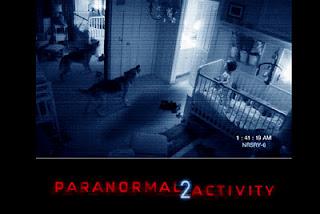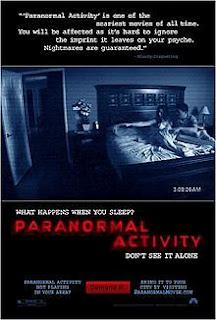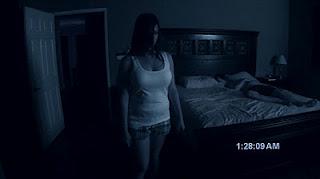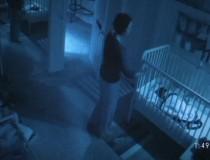
View Trailer and Clip!
 DEPTH: 3.5
DEPTH: 3.5ACTING: 4
PLOT: 4
ORIGINALITY: 4.5
ENTERTAINMENT: 5
DEMAND ON VIEWER: Moderate to High (for scariness)
OVERALL: Recommended

If scariness makes a good horror film, these hit the mark. In fact, remind me not to see anything like this again soon. They are so terrifying that I am awake at 4:00 a.m. with the lights on to write this review. I recommend them for anyone who loves the feeling of fear when it does not involve something in your own life (and you don't mind losing a little sleep.)

I am not easily scared. Many horror films simply do not scare me. I watched the entire SAW series, for example, with intrigue but not fear. The Paranormals on the other hand somehow deeply penetrate one's mind and linger for days afterward.
The reason for this effect is not completely explainable, but a few things can be pointed out as part of the films' overall strength:
1. REALISM. The "found footage" format is highly effective. Even though this has been done before in films such as Blair Witch, the device is put to particularly good use here. In the first film, almost all the action takes place from one viewpoint, taken from a camera on a tripod in the corner of the bedroom. This is like good theater: how many ways can a single room be presented? And for this genre, remaining scary within that narrow constraint is a real achievement. (This effect is somewhat diluted in the second and third films.) One particularly effective device is the fast-forwarding clock indicator, indicating a real sense of a 2:38 a.m. incident, and in one case showing a person standing at the bedside for literally hours.
2. SILENCE. Some of the scariest moments in these films are when nothing at all is happening. A camera pans back and forth; you wait gripping the chair, trying to steel yourself for what might be next. The absence of a soundtrack or any sound at all strangely amplifies these scenes. Perhaps that is why they linger long afterward, as we head back to our own non-soundtracked lives.
 3. RESTRAINT. There is a marked absence in these films of gore, makeup, and overt special effects. When the paranormal starts to occur, the result is that it seems that much more real and memorable.
3. RESTRAINT. There is a marked absence in these films of gore, makeup, and overt special effects. When the paranormal starts to occur, the result is that it seems that much more real and memorable.4. RHYTHM. A nice sense of rhythm happens as the silences are punctuated by sounds, footfalls, doors closing, and lights switching on and off, building to a very pleasing (if pleasing is the right word for scary) climax over time.
5. COMPOSITION. As I mentioned, the tightly composed one-room and one-house setting requires considerable creativity to work a story line. A VHS camera attached to an oscillating fan in Para 3 provides an eerie way to see the kitchen and dining room.
6. PENETRATION. Gradually the spirit forces in all three films work their way from being "external" to somehow inhabiting one of the characters. This element of penetration is what gives the films their extra staying power, because while you might be able to dismiss bumps in the night, the thought of having a demonic presence inside of you or your spouse or child really is not as easy to dislodge. Why is this so? I wonder if it is because of the deep inner knowledge we have of ourselves, as capable of dark acts. Or could it be rather a knowledge of what we do not know about ourselves, our subconscious realms?

There are a couple of further currents running through all three films, worth analyzing for their deeper commentary. One is the fact that the males simply do not take seriously the force they are up against. (The plot is strained by this at times: it is fairly unbelievable that no one ever seems to be able to call 911 or ask for more help.) In a show of bravado and control, they attempt to "document" the demonic, but in the end all this does is antagonize things. The wives simply do not want to acknowledge or talk about it, and again, this avoidance only makes things worse. While the films do not overtly make an effort at being more than simply scary, there is a subtle message here: the suburban family is in a sense deeply unspiritual—and therefore vulnerable to attack from spiritual forces.
 The second commentary is on media itself: the presence of it only antagonizes the spiritual forces. One wonders whether the writers were trying to get us to ponder the ubiquitous presence of the camera, and the unreasonable fear that it can produce: "It feeds on fear." Think of the unnecessary anxieties of the modern era produced by instant news. This sort of sensationalism is what drives the sort of uber-adolescent male depicted in these films to try to capture something that cannot, and should not ever, be captured.
The second commentary is on media itself: the presence of it only antagonizes the spiritual forces. One wonders whether the writers were trying to get us to ponder the ubiquitous presence of the camera, and the unreasonable fear that it can produce: "It feeds on fear." Think of the unnecessary anxieties of the modern era produced by instant news. This sort of sensationalism is what drives the sort of uber-adolescent male depicted in these films to try to capture something that cannot, and should not ever, be captured. So with that as a warning, I will turn off the computer, TV, and lights, and try to get some sleep.
